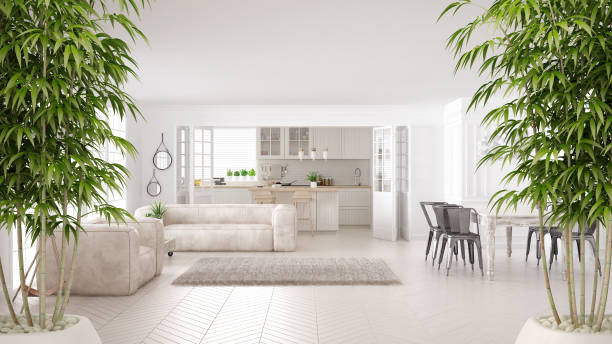Feng Shui for Home Buying
Feng Shui Considerations for Property Layout: Designing Your Home for Harmony and Balance
Designing your home according to Feng Shui principles can greatly enhance the harmony and balance in your living space. Feng Shui, the ancient Chinese art of arranging spaces to promote well-being and prosperity, emphasizes the importance of layout in creating a positive environment. Here’s a comprehensive guide to applying Feng Shui considerations to your property layout for optimal harmony and balance.
1. Understanding Feng Shui Layout Principles
Feng Shui Basics:
- Chi (Qi): The flow of energy in your home. Proper layout ensures smooth circulation of chi.
- Five Elements: Wood, Fire, Earth, Metal, and Water, which should be balanced in your design.
- Yin and Yang: The balance between opposing forces to create harmony.
Key Feng Shui Areas:
- Bagua Map: A tool used to map different life areas (e.g., wealth, health) in your home.
2. Designing with Chi Flow in Mind
**1. Entryway:
- Welcoming Entrance: The entryway is the primary area where chi enters your home. Ensure it is clean, well-lit, and inviting.
- Avoid Obstructions: Keep the entrance free from clutter and obstacles to allow chi to flow smoothly into the home.
**2. Room Layout:
- Open Spaces: Favor open and flowing spaces to facilitate good chi circulation. Avoid blocking pathways with large furniture or partitions.
- Room Function: Align the placement of rooms with their function. For instance, place the kitchen in a position that supports health and prosperity.
**3. Furniture Arrangement:
- Command Position: Arrange key furniture pieces, such as beds and desks, in a command position where you can see the door without being directly in line with it. This positioning enhances a sense of security and control.
- Avoid Sharp Angles: Position furniture to avoid sharp angles pointing directly at seating areas, as these can create disruptive energy.
3. Balancing the Five Elements
**1. Wood:
- Incorporation: Use wooden furniture or plants to represent the Wood element. This promotes growth and vitality.
- Color: Opt for greens and browns to enhance the Wood element.
**2. Fire:
- Incorporation: Introduce elements of Fire through lighting, candles, or red accents. Fire energizes and adds passion.
- Color: Use red, orange, or purple to stimulate the Fire element.
**3. Earth:
- Incorporation: Use ceramics, stone, or earthy colors to represent the Earth element. Earth provides stability and nourishment.
- Color: Incorporate shades of beige, yellow, and terracotta.
**4. Metal:
- Incorporation: Include metal accents, such as sculptures or frames. Metal adds clarity and precision.
- Color: Utilize metallic colors like gold, silver, and white.
**5. Water:
- Incorporation: Integrate Water features like fountains or mirrors. Water symbolizes abundance and flow.
- Color: Use blues and blacks to represent the Water element.
4. Creating Harmony in Key Areas
**1. Living Room:
- Center of Activity: Position the living room centrally to act as a communal space. Arrange seating to encourage conversation and interaction.
- Balance: Maintain a balance of elements to create a harmonious environment.
**2. Bedroom:
- Restful Placement: Place the bed in a command position and avoid having it directly in line with the door. This setup supports restful sleep and security.
- Calm Colors: Use soothing colors and avoid clutter to create a serene sleeping environment.
**3. Kitchen:
- Health and Prosperity: The kitchen represents health and wealth. Ensure it is clean and well-organized. Place the stove in a position where you can see the entrance.
- Balance: Incorporate all five elements to promote balance and nourishment.
**4. Office or Study Area:
- Productivity: Position the desk to face the entrance of the room. This arrangement helps to enhance focus and productivity.
- Organized Space: Keep the area clutter-free to maintain a clear and productive environment.
5. Addressing Potential Issues
**1. Clutter and Obstructions:
- Declutter Regularly: Regularly declutter to prevent stagnation of chi. Clutter can block positive energy and create imbalance.
- Organize Storage: Use smart storage solutions to keep spaces organized and free from unnecessary items.
**2. Mirror Placement:
- Proper Use: Place mirrors thoughtfully to reflect light and positive energy. Avoid mirrors directly facing doors or beds, as they can disrupt energy flow.
**3. Sharp Angles and Edges:
- Softening Angles: Use plants or screens to soften sharp angles that may create disruptive energy. Ensure furniture placement minimizes these issues.
6. Consulting a Feng Shui Expert
**1. Professional Assessment:
- Expert Guidance: Consider consulting a Feng Shui expert for a detailed assessment of your property. They can provide personalized recommendations based on the unique characteristics of your home.
**2. Customized Solutions:
- Tailored Advice: A Feng Shui expert can offer customized solutions to optimize the energy flow and balance in your home, ensuring it aligns with your specific needs and goals.
Conclusion
Designing your home with Feng Shui principles in mind involves thoughtful consideration of layout, balance, and energy flow. By focusing on key areas like the entryway, room arrangement, and element balance, you can create a harmonious and balanced living environment. Whether you’re making minor adjustments or seeking expert advice, applying Feng Shui principles can enhance your home’s energy and support a more positive and fulfilling living experience.

